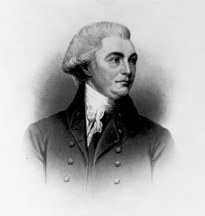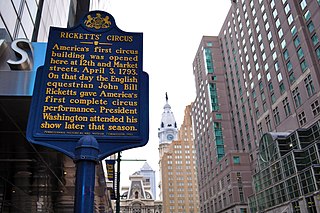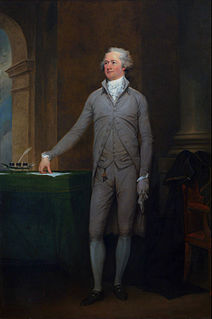
George Washington (Constable-Hamilton Portrait) is an oil on canvas painting by American artist Gilbert Stuart, made in 1797. It is held at the Crystal Bridges Museum of American Art, in Bentonville, Arkansas.

George Washington (Constable-Hamilton Portrait) is an oil on canvas painting by American artist Gilbert Stuart, made in 1797. It is held at the Crystal Bridges Museum of American Art, in Bentonville, Arkansas.
This painting was meant to commemorate the Jay Treaty of 1795, between the United States and the United Kingdom, as an offering to Alexander Hamilton, which was one of the greatest promoters of the treaty. The signed document sits on President George Washington's lap. This treaty, signed on November 19, 1794, was ratified on August 14, 1795, by the United States Senate and by Great Britain on October 28, 1795. Jay Treaty authorized the British Navy to confiscate goods of French origin transported on United States ships; but it was also forbidden for American ships to transport sugar, cotton and other colonial foodstuffs to any country other than the United States. [1]
The gift of an original portrait of President Washington acknowledged the role and support of Hamilton in Jay Treaty.
Stuart represented President George Washington at work, in his studio in Philadelphia. Although he is wearing a suit, instead of an army uniform, his sword on his lap indicates the president's military role, while the document signed G. Washington represents his position as a legislator and diplomat. The painting can be interpreted as presenting the President as someone who must always be ready to defend his country with arms; but upon his sword is the document of the treaty, as a sign that it is the time of diplomacy. The white space below the signature indicates that there is still a long way to go, down the path of agreements.
In the background of the painting there are ships, one of which bears the American flag, fighting over trade issues, unresolved at the end of the American Revolution. Jay's Treaty therefore is meant to prevent such skirmishes and to provide for peaceful trade between the United States and Great Britain.
This painting was given to Alexander Hamilton by William Constable, who participated in American political affairs. The seascape, unparalleled in Stuart's portraits of Washington, refers to Alexander Hamilton's interest in American trade policy. [2]
After several owners, the painting was sold at Sotheby's New York City, on November 30, 2005, for US$8,136,000 to the Crystal Bridges Museum of American Art, in Bentonville.

The Treaty of Amity, Commerce, and Navigation, Between His Britannic Majesty and the United States of America, commonly known as the Jay Treaty, and also as Jay's Treaty, was a 1794 treaty between the United States and Great Britain that averted war, resolved issues remaining since the Treaty of Paris of 1783, and facilitated ten years of peaceful trade between the United States and Britain in the midst of the French Revolutionary Wars, which began in 1792. The Treaty was designed by Alexander Hamilton and supported by President George Washington. It angered France and bitterly divided Americans. It inflamed the new growth of two opposing parties in every state, the pro-Treaty Federalists and the anti-Treaty Jeffersonian Republicans.

Visual art of the United States or American art is visual art made in the United States or by U.S. artists. Before colonization there were many flourishing traditions of Native American art, and where the Spanish colonized Spanish Colonial architecture and the accompanying styles in other media were quickly in place. Early colonial art on the East Coast initially relied on artists from Europe, with John White the earliest example. In the late 18th and early 19th centuries, artists primarily painted portraits, and some landscapes in a style based mainly on English painting. Furniture-makers imitating English styles and similar craftsmen were also established in the major cities, but in the English colonies, locally made pottery remained resolutely utilitarian until the 19th century, with fancy products imported.

Gilbert Charles Stuart was an American painter from Rhode Island Colony who is widely considered one of America's foremost portraitists. His best-known work is an unfinished portrait of George Washington, begun in 1796, which is sometimes referred to as the Athenaeum Portrait. Stuart retained the portrait and used it to paint scores of copies that were commissioned by patrons in America and abroad. The image of George Washington featured in the painting has appeared on the United States one-dollar bill for more than a century and on various postage stamps of the 19th century and early 20th century.

John Trumbull was an American artist of the early independence period, notable for his historical paintings of the American Revolutionary War, of which he was a veteran. He has been called the "Painter of the Revolution".

The National Portrait Gallery is a historic art museum between 7th, 9th, F, and G Streets NW in Washington, D.C., in the United States. Founded in 1962 and opened to the public in 1968, it is part of the Smithsonian Institution. Its collections focus on images of famous Americans. The museum is housed in the historic Old Patent Office Building, as is the Smithsonian American Art Museum.

William Bingham was an American statesman from Philadelphia. He was a delegate for Pennsylvania to the Continental Congress from 1786 to 1788 and served in the United States Senate from 1795 to 1801. Bingham was one of the wealthiest men in the United States during his lifetime, and was considered to be the richest person in the U.S. in 1780.

Thomas Sully was a portrait painter in the United States. Born in Great Britain, he lived most of his life in Philadelphia, Pennsylvania. He painted in the style of Thomas Lawrence. His subjects included national political leaders such as United States presidents: Thomas Jefferson, John Quincy Adams, and Andrew Jackson, Revolutionary War hero General Marquis de Lafayette, and many leading musicians and composers. In addition to portraits of wealthy patrons, he painted landscapes and historical pieces such as the 1819 The Passage of the Delaware. His work was adapted for use on United States coinage.

Scene at the Signing of the Constitution of the United States is a 1940 oil-on-canvas painting by Howard Chandler Christy, depicting the Constitutional Convention signing the U.S. Constitution at Independence Hall in Philadelphia on September 17, 1787. Along with Washington Crossing the Delaware by Emanuel Leutze, the painting is one of the most famous depictions of the early days of the United States. Christy created the painting in April 1940; it is so large that he painted it in a sail loft. It currently is displayed along the east stairway in the House of Representatives wing in the Capitol building.

The Lansdowne portrait is an iconic life-size portrait of George Washington painted by Gilbert Stuart in 1796. It depicts the 64-year-old President of the United States during his final year in office. The portrait was a gift to former British Prime Minister William Petty, 1st Marquess of Lansdowne, and spent more than 170 years in England.

Crystal Bridges Museum of American Art is a museum of American art in Bentonville, Arkansas. The museum, founded by Alice Walton and designed by Moshe Safdie, officially opened on 11 November 2011. It offers free public admission.
Jean Baptiste Casmiere Breschard was a circus owner and equestrian performer in the Circus of Pepin and Breschard.

The presidency of George Washington began on April 30, 1789, when Washington was inaugurated as the first president of the United States, and ended on March 4, 1797. Washington took office after the 1788–1789 presidential election, the nation's first quadrennial presidential election, in which he was elected unanimously. Washington was re-elected unanimously in the 1792 presidential election, and chose to retire after two terms. He was succeeded by his vice president, John Adams of the Federalist Party.

John Bill Ricketts (1769–1802) was an English equestrian who brought the first modern circus to the United States.
Jane Stuart was an American painter, best known for her miniature paintings and portraits, particularly those made of George Washington. She worked on and later copied portraits made by her father, Gilbert Stuart, and created her own portraits. In the early 19th-century, she assumed the responsibility of supporting her family after her father's death. She first worked in Boston, but later moved to Newport, Rhode Island, where she was the first woman who painted portraits. In 2011, she was inducted into the Rhode Island Heritage Hall of Fame.

Alexander Hamilton is a marble bust portrait of Alexander Hamilton, done in the style of a Roman Senator, by the Italian sculptor Giuseppe Ceracchi. Ceracchi also created many replicas, in both marble and plaster. The bust was later used as a model for sculptures and paintings.

George Washington is a marble bust portrait of George Washington, done in the style of a Roman emperor, by the Italian sculptor Giuseppe Ceracchi. It was created as part of a campaign by Ceracchi to build a larger monument to Washington. The bust was thought by many to be one of the most lifelike. It was later used as a model of Washington for works by other sculptors and engravers.

Alexander Hamilton is a 1792 full-length portrait of Alexander Hamilton by John Trumbull. It is one of multiple paintings John Trumbull made of Alexander Hamilton.

The history of U.S. foreign policy from 1776 to 1801 concerns the foreign policy of the United States during the twenty five years after the United States Declaration of Independence (1776). For the first half of this period, the U.S. foreign policy was directed by the Second Continental Congress and the Congress of the Confederation. After the ratification of the United States Constitution in 1788, U.S. foreign policy was conducted by the presidential administrations of George Washington and John Adams. The inauguration of Thomas Jefferson in 1801 marked the start of the next era of U.S. foreign policy.
The presidency of George Washington began on April 30, 1789, when George Washington was inaugurated as the first president of the United States, and ended on March 4, 1797.

Joseph Harrison Jr. was an American mechanical engineer, financier and art collector. He made a fortune building locomotives for Russia, and was decorated by Czar Nicholas I for completing the Saint Petersburg-Moscow Railway.